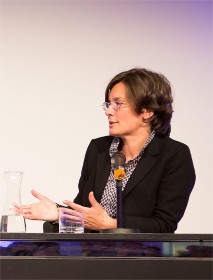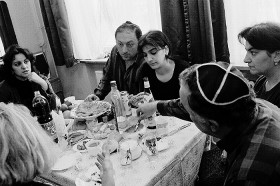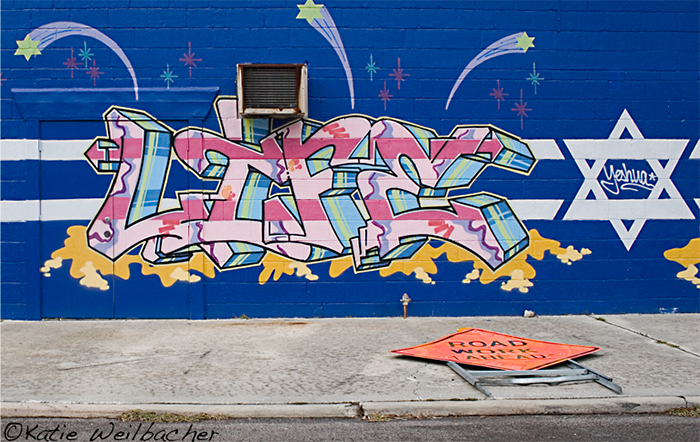
Dr. Karen Körber, the first scholar ever to benefit from the Fellowship Program of the Jewish Museum Berlin © JMB, Photo: Ernst Fesseler
The Jewish community in Germany has undergone a profound change in recent years—and the protagonists behind that change are the primary focus of research undertaken by Dr. Karen Körber, the first scholar of the Fellowship Program of the Jewish Museum Berlin. For the last two years Dr. Körber has been investigating “Daily Realities: Jewish Life in Germany Today” and she recently spoke to me about her findings.
Karen, the Fellowship Program of the JMB supports research into Jewish history and culture as well as into broader-ranging aspects of migration and diversity in Germany. You are the first person ever to complete the two-year Fellowship Program—a pioneer, so to speak—and I’d be interested to hear about that experience.
I found myself in a very open situation and was able to do much as I liked. All fellowship programs are fundamentally privileged set-ups but this particular one has the advantage of being attached to a well-endowed institution of international renown.
How did you come to research the topic “Daily Realities: Jewish Life in Germany Today”?
I had touched upon the topic already in earlier projects and was actually in the throes of research into migration from Eastern Europe for my doctoral thesis when the Museum offered me a Fellowship. So it was perfect timing: I was able to bundle all my research interests and develop a specific new project based on them.
If the theme is Jewish life in Germany today, why did choose to focus on migrants from the former Eastern bloc?
Because they are the majority, numerically, and because their influence on the life of Germany’s Jewish community overall is decisive today—and will continue to be so.
Could you briefly describe the background to this situation?

In 2012, the Jewish Museum Berlin presented Michael Kerstgen’s photo exhibition »Russians Jews Germans« (Russians Jews Germans). Kerstgen is one of the rare photographers to have produced an extensive and long-term photographic record of the immigration of Russian-speaking Jews from the former USSR to Germany.
Michael Kerstgens, The Mirte family from Georgia in a transit facility in Weiden/ Oberpfalz 2001 © Jewish Museum Berlin.
Since the collapse of the East bloc in 1989/90, Jews from the former Soviet Union (USSR) have been able to migrate to Germany. Before that, Jewish communities here were mostly very small and graying dramatically: some 30,000 members in former West Germany and no more than 300 or 400 registered members in former East Germany. Of course these numbers increased enormously—and very rapidly—on account of the new arrivals. The Jewish Council of Germany estimates that there are now over 100,000 Jews actively involved in their communities and another 100,000 who are not. The trend to religious pluralism has accordingly become more marked and the number of Jewish educational institutions has increased.
And how is the situation today?
The Jewish communities here—and other similiar religious communities—are now faced with a dilemma: young people are not getting involved and the current members are growing old. These are the factors that prompted my research. If the younger generation represents the actual and future promise that is currently lacking in such institutions, it becomes a matter of urgency to ask: Where are the young people today, and what are they up to?
How did you go about finding answers to these questions?
One component of my research program was an online survey carried out in late 2013 among a specific target group, namely individuals aged between 20 and 40 who had migrated to Germany with their parents. We asked them what it means to them to be Jewish, what they do, and how they live, etc. In addition, we carried out 30 in-depth interviews face to face.
What were the findings?
It is a fact that 35 percent of participants in the survey are no longer part of a community while the other 65 percent are made up of Liberal, Orthodox, Lauder and Chabad members. These findings confirmed the trend of pluralism and the growing lack of interest in established institutions. Regardless of whether or not they are part of a community, the majority of these young migrants see themselves as secular-liberal. Their self-image is shaped by their ethnic and cultural background but hardly at all by religion. They differ enormously in this respect from their parent’s generation. Their interest in Judaism is growing but it is typically a secular-liberal interest. Their sense of tradition and adherence to religious practice is accordingly weak and highly individual. The findings in this respect are very similar to those of the US-American PEW Study of 2013.

The international conference “Contemporary Jewish life in a global modernity: Comparative European perspectives on a changing diaspora« will focus on contemporary Jewish life in Europe.”
On 11 and 12 December, the major international conference “Contemporary Jewish life in a global modernity: Comparative European perspectives on a changing diaspora” will take place at the JMB and I imagine you will probably present your research findings there.
That’s right. I will make a brief presentation. The conference aims to bundle together the major strands of contemporary discourse and so my topic fits in well—for describing processes of individuation and diversification is an integral part of that discourse.
These processes are not found only within the Jewish community…
That’s right. They are a widespread phenomenon. But they bring up issues specific to the Jewish community and a pivotal aspect of the conference will therefore be the crucial question: How do people relate to this religion? The wave of immigration from the former USSR has turned the spotlight on the complex issues raised by this question both in Germany and in Israel. And ultimately, the question also has a political dimension. We have to consider how Jewish contemporary life may develop in a Europe wracked by on-going conflict: conflict within the community as well as conflict with other social groups. All these issues will be addressed at the conference.
And the findings will be compiled in the next issue of the Studies of the Jewish Museum Berlin?
Exactly. In publishing a compilation of papers by scholars of cultural studies and the social sciences on Germany’s Russian-speaking Jewish immigrant population, the journal will present interdisciplinary perspectives on how phenomena such as mobility, migration, the growing trend to pluralism in cultural practice, and the plural identities to which these give rise are shaping contemporary Jewish life in Germany.
Interview by Alice Lanzke, Media